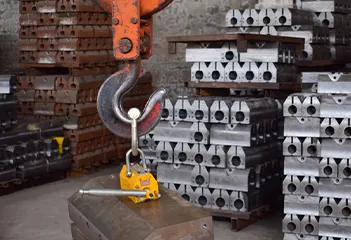Design and Analysis of Gantry Crane Girders for Enhanced Structural Efficiency
Understanding Gantry Crane Girders An Essential Component in Heavy Lifting
In the realm of industrial machinery and construction, gantry cranes play a pivotal role in facilitating the movement of heavy loads. A key component of these cranes is the girder, which serves as a structural backbone, enabling the crane to lift and transport large items with stability and precision. This article delves into the significance, design, and applications of gantry crane girders, highlighting their importance in various industries.
What is a Gantry Crane?
A gantry crane is a type of crane that consists of a lifting mechanism mounted on a structure that moves along a set of tracks. Unlike overhead cranes, which are fixed in place, gantry cranes are movable and can cover large areas, making them ideal for various outdoor and indoor applications, especially in shipyards, warehouses, and construction sites. The crane's body is supported by two or more legs, which straddle the load, and the girder is the horizontal beam that connects these legs.
The Role of the Girder in Gantry Cranes
The girder is a crucial element of a gantry crane, as it supports the weight of the load being lifted and ensures the stability of the entire system. Generally constructed from high-strength steel, girders must withstand significant forces while maintaining structural integrity. The design of the girder often involves intricate calculations to ensure it can handle the maximum load capacity while remaining lightweight enough for mobility.
Gantry crane girders are typically classified into two main types single girders and double girders. Single girder cranes have a single beam that runs across the width, making them lighter and more cost-effective for smaller tasks. In contrast, double girder cranes utilize two beams for increased stability and load capacity, making them suitable for heavier applications.
Design Considerations
When designing a gantry crane girder, several factors must be taken into account
1. Load Capacity The primary factor influencing the design is the maximum load the crane is expected to lift. Engineers must calculate the stresses and strains the girder will experience during operation to ensure safety.
gantry crane girder

2. Material Selection High-strength steel is commonly used for girders due to its excellent durability and resistance to deformation. However, other materials such as aluminum or composite materials may be considered based on specific project requirements.
3. Environmental Conditions For outdoor applications, the girder must be designed to withstand weather elements such as rain, snow, and wind. Proper coatings and treatments can enhance corrosion resistance and extend the girder's lifespan.
4. Mobility If the gantry crane needs to be portable, the girder's design must allow for easy assembly and disassembly while ensuring stability during operation.
Applications of Gantry Cranes
Gantry cranes find applications across a wide array of industries. In manufacturing, they are used for assembling and moving heavy machinery. In construction, they aid in lifting building materials and equipment to various heights. Shipyards utilize gantry cranes for loading and unloading large ships, where precision and strength are critical.
Moreover, gantry cranes are beneficial in logistics and warehousing. They enable efficient movement of goods, reducing the risk of damage during transportation. Their versatility also allows them to be adapted for various tasks, ranging from automotive assembly lines to aerospace manufacturing.
Innovation and Future Trends
As industries evolve, so too do the technologies surrounding gantry cranes and their girders. Innovations such as automated controls, improved materials, and IoT integration are enhancing the performance of these cranes. Furthermore, the trend towards heavier loads and increased efficiency is driving the development of even more robust and adaptable girder designs.
In conclusion, gantry crane girders serve as a fundamental component in the operation of gantry cranes, providing the necessary structural support for heavy lifting tasks across various industries. With careful design considerations and ongoing innovations, these girders will continue to play a vital role in enhancing operational efficiency in the years to come. Whether in construction, manufacturing, or logistics, understanding the importance of gantry crane girders is essential for anyone involved in heavy lifting operations.
-
Unlock Seamless Relocation with Our Heavy Equipment Moving ExpertiseNewsJun.06,2025
-
Unleash Unrivaled Flexibility with Our Adjustable Gantry CraneNewsJun.06,2025
-
Unleash Heavy-Duty Efficiency with Our Industrial Gantry Crane SolutionsNewsJun.06,2025
-
Revolutionize Steel Handling with Our Magnetic Lifter RangeNewsJun.06,2025
-
Master Equipment Mobility with Premium Machinery Mover SolutionsNewsJun.06,2025
-
Elevate Your Material Handling with Magnetic Lifter TechnologyNewsJun.06,2025
-
YS Permanent Lifting Magnets: The Smarter Way to Handle SteelNewsMay.22,2025
